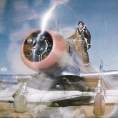-
Posts
3,779 -
Joined
-
Last visited
-
Days Won
25
Content Type
Profiles
Forums
Blogs
Gallery
Downloads
Media Demo
Events
Everything posted by GeeBee
-
I did not see the difference either until one day returning from KUCY to KGVL. As I was dodging CBs, I was switching back and forth between FIS-B and XM. I do not use either for tactical use, but I do use it strategically. Basically if I cannot see blue sky, I'm not using these products to stay out of the nasty. XM picked up a thick line of TS over CHA much earlier than FIS B and I was able to reroute myself down around Huntsville, where there was a much looser line and back up to north Georgia. As I came up to GVL I could see quite clearly that the XM representation was more accurate. If I lived in the South, the Ohio/MS valley or the OK, TX panhandle I would buy XM in a heartbeat and use both FIS-B and XM looking for the latest update. Out west or up north where things are a little more distinct, slow developing and isolated FIS-B may be enough. In the above mentioned areas, you can spit on the sidewalk and get a TS going. Things develop too fast and make the risk of stumbling into embedded weather to risk less than maximum update rates.
-

I guess I’m out of the cheap b@st@rds club..
GeeBee replied to ragedracer1977's topic in Miscellaneous Aviation Talk
Very nice. I flew a Turbo Q model all over the US years ago. Great airplane, flies solid. I also flew. one of the "Sky King" 310s. -
Make sure who ever you choose has no connection to previous work on the airplane.
-
Quarterly is not often enough
-
You need a GDL 69 https://buy.garmin.com/en-US/US/p/228
-
Mooneymite is correct. I had the same question when a MSC signed off my annual in the airframe log then signed off the engine and the prop as "100 hour" inspections I inquired to my personal IA. He said what Mooneymite said and he said if you notice I write mine up as "performed 100 hour inspection on engine in conjunction with an annual inspection" on NXXX. I think either by habit or tradition we have mostly seen engines signed off as "annual inspection" but Mooneymite's assertion is absolutely correct. Either way, you're good.
-
I was looking for this. Found it. https://www.kitplanes.com/the-effects-of-ignition-advance-on-cylinder-head-temperature-speed-and-efficiency/ The money line, The gains from varying just the ignition timing are real, but small. Most of the efficiency advantage of EI systems likely comes from a higher energy and longer duration spark that allows LOP mixtures to be ignited reliably at high altitude. Once you can ignite a LOP mixture, subsequently varying the timing only has a small impact.
-
The problem is, this. The manufacturers have raised parts prices so much it is difficult for a rebuilder to replace all the things he wants, and come out ahead after figuring his labor. The last O-320 B2B I had rebuilt was a thing of beauty. Pegged main bearings, flow matched, ported and polished cylinders etc. The reality is, after all was said and done I would have been better off just calling Air Power Inc. and buying a Factory Zero Time engine. Cost would have been the same, and there would have been less down time. A Zero Time will provide the best resale value and it is likely you will sell this airplane before the next engine. You also get the added benefit of a roller cam and lifters. Lycoming is the only folks who can put these into a rebuild. Exchange from Airpower is 37K. Continental is even worse. They raised the prices on parts and lowered the overhaul price of an IO-550 it is impossible for the field shops to come out. A field is about 43, Factory zero is 46 and brand new is only 55! I used to be a big advocate of field overhauls by a good builder, but now unless you really want some boutique items like flow match cylinders, etc I would go with a factory exchange. Quickest way back to the air, best resale.
-
You want to be checking your tire pressures regularly.
-
Looks to be a blast to fly and if it meets your mission needs (2 place, limited baggage, limited IFR) go for it! (Does not have a magneto ignition though, just sayin )
-
Most the problems I am seeing with electronic are mechanical, not electrical. The largest producer of aircraft gasoline powered engines right now is Rotax. Are they using magnetos? Hear of a lot of ignition problems with Rotax? You can continue to defend magneto ignition, invented in the 19th century to run our airplanes in the 21st century. We should demand better because we should be getting better 20 years into the 21st century. So many good things would come out of a hotter and longer spark for the efficiency and longevity of our engines. If I were a cylinder or valve manufacturer, I would be cheering on fixed timing, magneto ignitions.
-
As an FAA friend once said to me. "IF I wanted to retire, I would go to the. small plane air cargo ramp at LAX or MIA and just start in. I could generate enough violations to last a career." I flew for several companies in that time period, and the operation of Part 23 aircraft in daily scheduled operations is a perilous one. The airplanes are not designed for that kind of use and it shows quickly. In the 70's flying jobs were not easy to come by (lots of VietNam vets), multi time was a god send, and a dismissal from a crap operator would be the end of airline dreams. Things were not always as fat as they are now. Back then, you were expected to complete the mission, or they would get someone else very quickly. I worked for on operator who would fire a pilot who shut down engines and could not restart, even if it was a starter failure. You were expected to leave them running, during loading and unloading.
-
In your hostility, you missed the point, or points (pun intended). You are not going to see an engine quit due to a mag failure, because......ta da! There are two of them. You are more likely to see a return to base in the case of a mag failure, than an engine failure because most pilots are unwilling to risk flight on one system. Glad to see you have 31 years, but I have 20 more than that, 47 in fleet operations, so let us not get too caught up in mine's bigger and seek a larger truth. Mags suck. They have lots of failure points that require attention and put out a weak spark in comparison to modern systems.
-
Probably about 6 or seven in 8k hours. I used to fly checks at night, lots of bad leads rotors etc. which is caused by guess what? Bad mag. That is just me. Now think about 25 airplane fleet every night.
-
If you are worried about the future value of an airplane to purchase, you can’t afford it to start with. Prices go up, they go down. The one constant is when you open your hangar door she is there and she is yours, everything else is pure speculation.
-
Not really the point. How many taxi backs to the hangar for a bad mag check? A lot.
-
As far as that unit goes, I am not a buyer. I have seen too many problems with it.
-
Ahhhh, the coil.....
-
So which has a higher failure rate on cycles, points or FET's? We have FET's going 1 million miles in giant electronically controlled diesels as cam sensors.
-
Looks like mine is not in as good a shape as it should be, despite declarations to the contrary. It sure does get hot though. I can see it steaming when flying through precipitation.
-
No, we are much better off. We still have coil, but not a weak reversing coil, and we don't have points. We would also have variable timing, and a hotter spark. If you want LOP operations you must have a strong and durable spark. How do you think automobiles get away with .065 gaps? More voltage equals more potential to jump the gap and the larger the gap, the bigger the spark. In all my years of aviating with thousand of hours flying PMA's, I have never seen a PMA fail.
-
If you wanted to power an electronic mag in a fail safe manner, easy. Use a PMA. Permanent Magnet alternator encased with the unit. That is how a lot of FADECs on turbines are powered. Newer PMA's have a very strong field that can generate lots of juice.
-
I would agree with you there is a lot of poor installations, and poor installations have a far more catastrophic effect which is why they are so notable. However, I would want you to think about coils for a minute. You notice they are missing from your picture and that is no reflection on those folks in Montana. They are the best in the world IMHO, but they follow the book in a competitive business. Think about this. We can visually (sometimes with a glass) inspect everything in the magneto but the coil and make a statement about its condition. The one thing we cannot inspect is the coil. Nor can we stress test a coil. Sure we can test the resistance, but we know resistance changes dramatically with heat, but more important, the dielectric properties of the insulation within the coil break down under heat and long term vibration. So we replace everything we can visually check, but do little with the one component we cannot faithfully inspect. Does that make sense? Nor are the effects of poor coil performance immediately apparent. It backs up onto the points and condenser and sometimes aids the aging of the caps and wires. People are often at a loss about point deterioration blaming the condenser when in fact, it is bad coil performance. I had an old auto mechanic who told me on battery systems, to replace the coil every 50K miles. I was part a the classic car community and I found his advice resulted in a lot less point maintenance. He also issued a caveat that if it was a Lucas system, every 20K because well, Lucas is the prince of darkness.
-
I. use this unit https://www.aircraftspruce.com/catalog/elpages/portPowerCharger24ces.php?clickkey=1274392
-
Think about it. How long until the cast housing stretches? You can put all the new "guts" in, but when you are finished, you still have a cast housing that is taking a beating, from the bearing races to the seal seats, to the threads the screws turn into, not to mention the flanges which are bolted down with steel billets. Also for whatever reason, many places check the coils but do not replace the coils. Seen a lot of recently O/H mags come up with a bad coil, because they test good on the bench until you heat stress them then it all goes bad. After 1000 hours, I want a new coils and a new coils are about 400 bucks. Add in the rest of the parts and labor and you might as well buy new. Plus when it goes bad, there is no head scratching and "I'll send it back for a rework", you get a new magneto. IMHO, in a SE airplane, the gods of high tension electricity must all be simultaneously appeased for their wrath of each is mighty.




